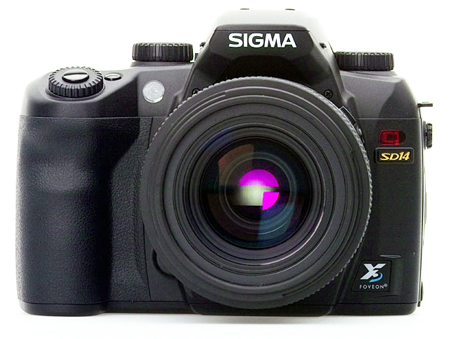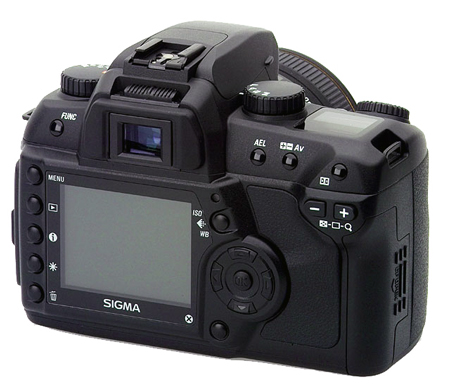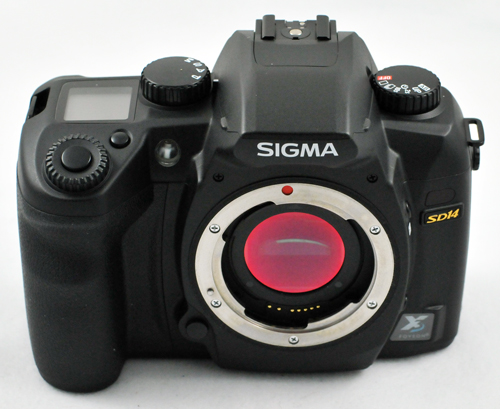Sigma SD14: Quick Look at a Quirky Wonder
by Wesley Fink on June 3, 2008 4:20 AM EST- Posted in
- Digital Camera
Evolution of the SD14
It
is impossible to talk about the specifications, controls, and features of the SD14
without comparing it to the cameras that came before it - the Sigma SD9 and SD10.
Sigma has really refined the SD14. The area that stands out most in the new design is the viewfinder.
The SD9 and SD10 used the old Sigma 35mm viewfinder with dotted lines to show the
new view of the 1.7x sensor. It was almost laughable that their marketing referred to this as some
special form of sports finder where you could see what was outside the frame and
moving into it. The SD9 and SD10 were so slow no one would ever
even consider using them for action photography, so it was all too clear that Sigma
was just recycling an existing 35mm viewfinder.

Interestingly enough the SD14 viewfinder is quite decent. It is a pentaprism (not a pentamirror) and reasonably bright, with 98% horizontal and vertical coverage. This is better coverage than the 95% of the 40D for example, but the Canon 40D has a better .95x magnification compared to the .9x of the SD14. However, compared to the earlier SD10 magnification of .77x the new SD14 viewfinder is dramatically improved. Sigma also claims the viewfinder is high eyepoint, which makes it easier for eyeglass wearers to use. The eyepoint spec is 18mm, which is the same as the Nikon D3.

This is also the first Sigma SD with five AF points. The earlier SD9 and SD10 had a single-point AF module that looks about the same as the 15-year old SA300N. The five focus points are spread widely across the frame, which significantly increases the AF frame coverage on the SD14.

There is also an easy-to-adjust diopter correction on the top of the viewfinder, a real depth-of-field preview button on the left side of the lens mount, and the first built-in pop-up flash in the Sigma SD series. These are nothing special at the original selling price of $1699, but with Cameta and Amazon recently selling the SD14 body for less than $600 they are really standout features at the new price point.
There are also updates that are not so obvious in the SD14, such as USB 2.0 instead of 1.1 and a dramatically improved shutter with a rated life of 100,000 actuations. The new shutter tops out at 1/4000 instead of 1/6000 like the SD10, but a year in the field is proving the new shutter doesn't disintegrate and shred small pieces in the sensor chamber. This was a complaint some had with the SD10. The new shutter is also very quiet - much quieter than the earlier models - and frankly one of the quietest shutters we have found in any camera in its class. That is a welcomed improvement.
This is also the first Sigma SD to use a rechargeable Lithium battery. The earlier models used AA batteries or the CR-V3 variant. Thankfully the new battery is an easy-to-find and reasonably priced NP-400, a battery that is also used in the Minolta 7D/5D, and the Pentax K20D/K200D/K10D. Pentax calls their battery the D-Li-50, Sigma calls it the BP-21, and Minolta called the battery the NP400. Whatever they call it, all three batteries are interchangeable, which makes it easy to find reasonably priced replacement batteries.
Our early experience with battery life was extremely poor. This also appears to be related to the early CF compatibility issues we experienced. After charging to a different brand of CF card that worked better on the SD14 we fired off about 300 shots before depleting the battery. Battery life is better than we first thought, but it is not in the same league with Canon and Nikon CMOS sensors. It is probably a good idea to carry a spare battery or two if you plan a lot of shooting. Note that some users claim battery life does improve after the battery is "conditioned" in the Sigma charger.

As seen on previous SD cameras, Sigma mounts a sensor protector just behind the lens mount to keep dust away from the sensor. The reddish-pink filter inside the lens mount is also the Infrared filter. This makes the SD14 uniquely suited for digital IR photography since the filter is easy to remove without any special tools. The SD14 without this filter is sensitive to both IR and visible light, and by using an IR filter you can make the SD14 sensitive to IR only. The word among IR enthusiasts is that there is nothing better on the market for IR photography than the SD14, and that option is there if you choose.

Sigma uses the Sigma SD all-electronic lens mount, and can only natively mount Sigma lenses. Many photographers do not realize the Sigma mount is all-electronic like the Canon mount, and it has been in existence for more than 15 years. Here you see a very new 18-200mm OS (Optical Stabilized) Sigma lens mount beside a 15+ year old Sigma 50mm Macro lens. The 50mm Macro works perfectly on the new SD14. In fact, the Macro was used for most of the sample images at the end of this review.
Lenses for the SD14 are only available from Sigma, but the current Sigma lens catalog shows 39 lenses available in Sigma SD mount, and there are additional lenses that were made in Sigma mount that have been discontinued over the years. The lens multiplier is 1.7x, just slightly more than the Canon 1.6x, which means the equivalent 35mm focal length is the focal length times 1.7x. That means a 50mm normal lens behaves like an 85mm portrait lens on the SD14.
It is a little more work to find Sigma mount lenses for sale, but Amazon, Cameta, and B&H usually have a decent variety. Sigma also makes their most interesting new lenses, such as the new 18-200mm f3.5-6.3 OS available in Sigma mount. That lens on the Sigma, as with the Nikon 18-200mm VR, is quite a match. It provides a 35mm equivalent of 31-340mm in a single lens with up to four stops of added speed thanks to the new Sigma dual-motor OS.
You can also find Sigma-mount lenses for sale on eBay, sometimes at bargain prices. The Sigma-mount 35mm lenses will fit the new SD14 and they are often very cheap if you are trying to build a quality system on a shoestring.










40 Comments
View All Comments
cheetah2k - Wednesday, June 4, 2008 - link
I've bought over 100 memory cards on ebay, and all at respectable prices (here in Australia we still pay about US$30 for 2GB!) and I've never had a problem. I just purchased a nice 8Gb Sandisk Ultra III CF for my Sony A350, 4Gb CF Ducati, and 8gb Sandisk MicroSD just recently, and again without any errors or faults.The only way to test these cards also, is to fill em up to the hilt with data. At 14MP, and 1 day of continuous shooting, I easily fill 8Gb.
The advice here should be dont buy $0.99 memory cards from sellers with less than 20 sales and 99% good comments or you will end up with BS backdoor memory cards full of sawdust instead of the usual silicone
cheetah2k - Tuesday, June 3, 2008 - link
In terms of this review, I think Anandtech has lost the plot againWhy compare a 14MP camera with 10 and 12MP??
You've reviewed the Sony A350, why isnt that in your review?
You're just wasting your own time carrying out reviews like this with out proper comparisons. I guess thats just because Anandtech is trying to be a jack of all trades, but not doing it very well
Wesley Fink - Tuesday, June 3, 2008 - link
Others would argue we should only compare the SD14 to 6 Megapixel cameras, or even less, since it is really a 4.7MP finished image. Most consider the SD14 roughly competitive in the 10 Megapixel space - with some tilting toward the 8 megapixel side and others to the 12 Megapixel end. Our choices were representative of prosumer cameras many would consider as having good IQ in that megapixel range, which was our goal.If you wish to compare the images to the Pentax K20D and the Sony A350 the crops and full images can be found at http://www.anandtech.com/digitalcameras/showdoc.as...">http://www.anandtech.com/digitalcameras/showdoc.as...
cheetah2k - Wednesday, June 4, 2008 - link
I understand what others argue. However, when you're comparing cameras, you also need to compare cameras of equal MP, regardless of what their end result is. This then gives an unexperienced DSLR user the opportunity to compare and examine the results from, for example, how a sony 14MP camera produces vs SD14 14MP camera, etc. This way, for those wanting 14MP, they can establish good value for money and make a call on where they ultimately want to end up. Therefore, it would have been good to include the Sony A350 results that you got from a previous review.As noted above, in the case of Anandtech's past review of the Canon 450D (12.2MP) vs Sony A350 (14.2MP) vs Nikon 10.1MP cameras, I understand the varying MP review as that was all that was around at the time. From that review I actually purchased a Sony A350X set with the 2 lenses, as I established it was good value for money (and actually cheaper than the Canon 450D)
Some times a LIKE for LIKE comparrison is what we all need, especially for those of us who are non-pro photographers.
melgross - Wednesday, June 4, 2008 - link
I've never heard of this being compared to a 12 MP camera. 8 to 9 seems to be the agreed upon equivalent. And even there, it depends upon the images, some look sharper, and some less so.pinto4402 - Tuesday, June 3, 2008 - link
Amen to the comment about the CF issue. I feel better about the startup time, but now I'm troubled by the memory card problems. When you depend on your gear for your living, any possible point of failure is scary.pinto4402 - Tuesday, June 3, 2008 - link
Holy cow. I considered purchasing a Sigma for portrait work because other portrait photographers rave about the IQ of the foveon sensor. I'm shocked, however, by the 9 second start-up time. This is not something anyone has discussed before. It is simply unacceptable for any modern camera to have such primitive electronics. I know that there are many "artistes" out there who feel smug about how they can create beautiful images with primitive gear. I am not one of them. I want my camera to function well and stay out of my way.This is a good, fair summary of the camera. While "ease of use" is a subjective and nebulous concept, I think it's appropriate that you pointed out that the camera took 9 seconds to boot up and has a slow write time. Aside from IQ comparisons, this is the kind of useful information I'm looking for in a camera review.
Maxington - Wednesday, June 4, 2008 - link
If I was heavily into portraits I'd go with the Fuji DSLR's, with their specialized sensors, not the Sigma.I can't knock Sigma lenses, they have some gems, but their cameras so far are pretty lacklustre.
I'd like Foveon to stay around as competition though, maybe with development it will find its strong points.
pinto4402 - Wednesday, June 4, 2008 - link
My only experience with Sigma lenses turned me off to "generic lenses" forever. I had my camera with a Sigma 17mm lense slung on my shoulders. As I was leaning down to pick something, the camera swung down and hit the ground. Not too hard, but hard enough. The lense and camera continued to operate fine, so I thought nothing of it. When I got home and developed my slides, I noticed that there were stray light streaks in all my images (not typical lense flare). When I examined the lense more carefully, I noticed that its plastic casing had cracked. The rubber focusing ring had obscured the crack.I'm still ticked off about this to this day 15 years later because I was on a once-in-a-lifetime trip to Cambodia photographing Angkor Wat. All the hundreds of images I took with the Sigma had light streaks. Luckily, it was not a paying job, but the images had a lot of personal importance to me.
I've never had any such problems with the Canon L lenses, even though they've taken worse abuse. Their all metal build quality and wheather sealing (as well as fantastic optical quality) are the main reasons why I have been loyal to Canon even though Nikon, for now, has arguably superior cameras (D300, D3) to what I'm using (40D, 5D).
pinto4402 - Wednesday, June 4, 2008 - link
I agree that Fuji has found a place in the toolkits of many portrait photographers. The deal killer for me is that it has low resolution. I generally enlarge my prints to 24x36. An effective resolution of 6MP on the S5 Pro does not cut it. Come to think of it, the Sigma is probably not a good choice either because of its lower resolution. I've been a happy Canon 5D user, but I'm always looking for something different to add to my kitbag. That's why the foveon had some appeal.